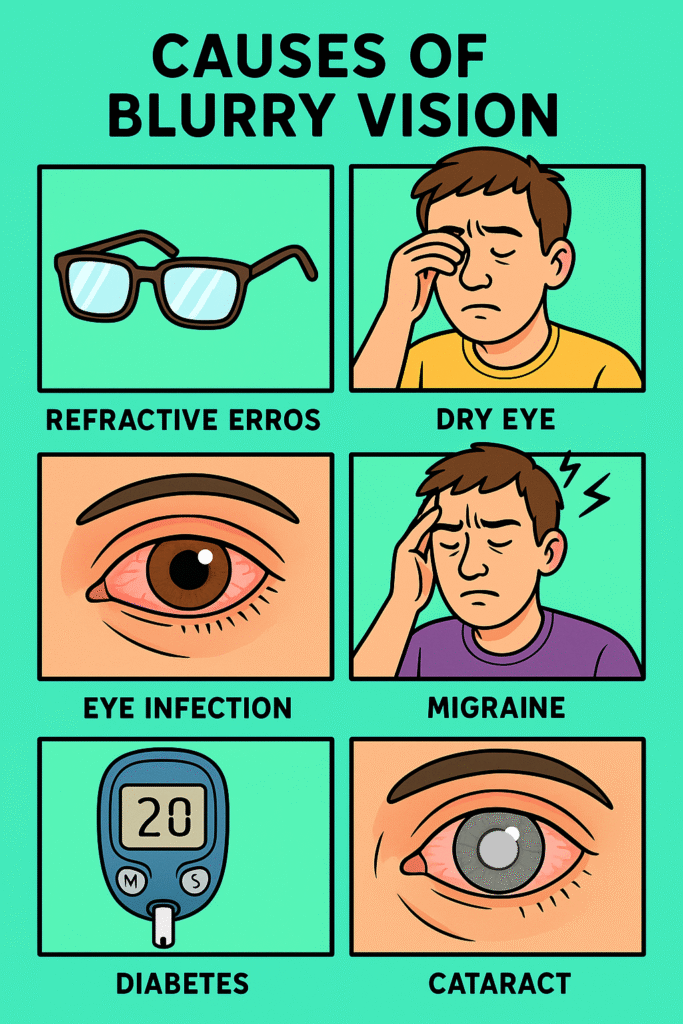Ever looked at something and realised it’s suddenly not as sharp as it should be? Maybe the letters on a sign are fuzzy, or your phone screen looks hazy. That’s blurry vision—a common symptom that can mean many things. Sometimes it’s harmless and temporary, like when you just woke up. Other times, it might be a sign of something more serious.
Let’s explore what causes blurry vision, when to worry, and what to do about it.
What Is Blurry Vision?
Blurry vision is a loss of sharpness or clarity in your eyesight. It can affect one eye or both, happen suddenly or develop slowly over time. Some people describe it like looking through a foggy window, while others feel like their eyes are just “out of focus.”
According to the American Academy of Ophthalmology, blurry vision is one of the most common complaints seen in eye clinics worldwide.
How Does Blurry Vision Happen?
Your eyes work like a camera. Light enters through the front (the cornea), passes through the lens, and focuses on the retina at the back of your eye. The retina then sends that information to your brain, which forms the image you see.
If any part of that system isn’t working properly, the image becomes blurry.
Imagine trying to take a photo without focusing your lens—that’s similar to how blurry vision feels.
What Causes Blurry Vision?
Blurred vision can happen for many different reasons. Here are the most common ones:
1. Refractive Errors (most common cause)
These include:
- Nearsightedness (Myopia) – Far objects appear blurry.
- Farsightedness (Hyperopia) – Near objects look blurry.
- Astigmatism – Both near and far objects can look distorted.
- Presbyopia – Trouble focusing up close due to aging (usually over 40).
🧠 About 75% of people with vision problems have one of these errors.
2. Dry Eyes
Your eyes need a healthy tear film to stay clear. Without enough moisture, your vision can appear blurry or “filmy,” especially after staring at screens for too long.
3. Eye Infections or Inflammation
Conditions like conjunctivitis, uveitis, or keratitis can cause blurring along with redness, pain, or discharge.
4. Migraine
Blurry vision or visual disturbances (like zigzag lines) can happen before or during a migraine attack, often called an “aura.”
5. Diabetes (Diabetic Retinopathy)
High blood sugar damages the blood vessels in the retina. Blurring can be intermittent or progressively worse.
6. Cataracts
As we age, the eye’s lens becomes cloudy—this leads to slow, painless blurring, glare at night, or faded colours.
7. Glaucoma
This is increased pressure inside the eye that can damage the optic nerve. It usually affects side (peripheral) vision first but may cause general blurring in advanced stages.
8. Macular Degeneration
Affecting the central part of the retina, this condition causes blurry central vision, especially in people over 60.
9. Eye Injury or Foreign Object
A scratch on the cornea (corneal abrasion) or even a speck of dust under your eyelid can lead to sudden blurry vision.
10. Stroke
If blurry vision is sudden and paired with weakness, slurred speech, or dizziness—go to the hospital immediately. This could be a stroke.

Risk Factors
Anyone can get blurry vision, but it’s more common if you:
- Are over 40 (age-related changes like presbyopia or cataracts)
- Have diabetes or high blood pressure
- Spend long hours looking at screens
- Wear contact lenses (especially if not cleaned properly)
- Have a family history of eye diseases
- Smoke (linked to macular degeneration and cataracts)
Other Symptoms That May Appear with Blurry Vision
Blurry vision often comes with other clues:
- Eye pain or redness → could be infection or inflammation
- Headache and nausea → could signal migraine or high eye pressure
- Floaters or flashes of light → may indicate retinal detachment
- Sudden loss of part of vision → an emergency (stroke or retinal damage)
If your vision suddenly changes, it’s always better to play it safe and get medical help.
Tests to Identify the Cause
The gold standard test is a comprehensive eye exam by an optometrist or ophthalmologist.
This may include:
- Visual acuity test (eye chart)
- Refraction test (to detect glasses power)
- Slit-lamp exam (looks at the front of your eye)
- Retinal exam (dilating the pupils to view the back of the eye)
- Tonometry (measures eye pressure)
In cases involving other systems (like diabetes or stroke), blood tests or brain imaging (CT or MRI) may be needed.
Treatment for Blurry Vision
Treatment depends on what’s causing the problem.
Mainstream Treatments:
- Refractive errors → Glasses, contact lenses, or LASIK surgery
- Dry eyes → Artificial tears, lid hygiene, screen-time breaks
- Infections → Antibiotic or antiviral eye drops
- Cataracts → Surgery to replace the cloudy lens with an artificial one
- Diabetic retinopathy → Blood sugar control, laser therapy, injections
- Glaucoma → Eye drops to reduce pressure, laser or surgery
- Macular degeneration → Anti-VEGF injections or supplements (AREDS)
If blurry vision is due to another medical condition (like migraine or stroke), managing the underlying disease is essential.
⚠️ Never ignore sudden or painful vision changes—seek help right away.
References
- Blurry Vision: Causes, Symptoms & Treatment – Cleveland Clinic (2023). https://my.clevelandclinic.org/health/symptoms/17960-blurry-vision
- What Causes Blurry Vision? – American Academy of Ophthalmology (2022). https://www.aao.org/eye-health/symptoms/blurry-vision
- Blurred Vision – Mayo Clinic (2024). https://www.mayoclinic.org/symptoms/blurred-vision/basics/definition/sym-20050803
